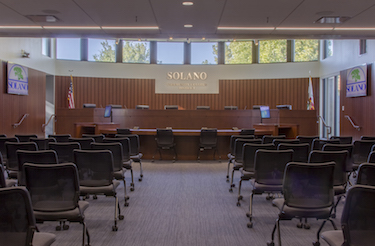AV/IT Paradigm Shift on Full Display at Solano College


Solano Community College set out to create the most technological boardroom out there, implementing a fully networked AV solution with Utelogy software as a service control, along with QSC, SVSi, Cisco, and Global CachéRoger Clague most certainly came to the table with an agenda. But unlike some of the other players circled around the discretely high-tech boardroom at Solano Community College, the self-proclaimed chief digital officer’s goals don’t align with selling products or services. His bipartisan, apolitical agenda “is just to deliver to our students the very best in education, using the latest technology that we possibly can.”
The occasion that December morning in Fairfield, CA, was to demonstrate a fully networked enterprise AV solution, complete with help desk service calls responded to from three different integrators, one of which, was over 8,000 miles away in Adelaide, Australia.
“I can now, using this kind of technology, deliver education to anywhere where students couldn’t have got higher education before,” Clague stated.
This includes the far parts of northern California where they don’t have programs for radio technicians, as Solano does. Yet, it’s much more than distance learning opportunities that Clague aspires to achieve.
“This technology, properly used in the classroom, is engaging for students,” Clague continued. “Student engagement is a huge problem today. Students get bored and disenchanted, and they lose track of why they’re at college sometimes. This kind of technology properly used is a game changer—it is transformational to what we’re doing.”
One of the unique aspects of the technology solution Clague spoke so fervently about is that it is a unified partner solution, with Utelogy’s software as a service control system as the backbone, chiefly teamed in this iteration with QSC, SVSi, Cisco, and Global Caché. The solution was deployed centrally in a virtual server without a single control panel. And oh, yea, the community college happens to have saved about $40,000 from the hardware-centric alternatives initially presented.
That $40,000 for Solano was about more than savings though. There’s significant value they can now extract through the additional ongoing services that the Utelogy solution provides. “If we can show that experts helping faculty design their courses around the technology has a direct, black and white data-driven effect on student learning outcomes, then we can probably get the funding for that,” explained Frank Pellkofer, Utelogy co-founder and CEO. “That’s all new value.”
A daily selection of the top stories for AV integrators, resellers and consultants. Sign up below.
Per example from Clague, by investing in engaging technology in the classrooms, more students will want to enroll, and you invest in distance education programs, further boosting enrollment, you can grow the front end of the college’s business by 10 percent. “That’s $5 million growth every year,” he proffered. All achieved by giving students material they want to learn in the format they want to consume it in. “The opportunity here is [that] you’ve got to change the mindset of a lot of the people in my position from one of streamlining the back end, to one of growing the front end.”
In other terms of added value, just the notion that three different integrators, in three very different locales, have the capability to serve one client is unprecedented. Solano has just begun to scratch the surface of the services this virtual environment is capable of supporting. Some more creative ideas being floated in the broader Utelogy sphere include remote career counseling or research library assistance, according to Kelly Weppler, Utelogy director of marketing.
Ultimately, the integrators are creating value that leads to stickier relationships with their customers. This concept epitomizes the paradigm shift the traditional AV integration model is in the throes of.
“This is a universe change,” commented Ron Baylin, president, Net-AV, a Maryland-based integrator. “To be able to really change the mentality in terms of presenting this as a whole solution, a partnered solution, but more importantly, looking at driving it as a consultative methodology to deliver outcomes. Which is a complete radical change.”
These factors all played into the strategy for Redding, CA-based Development Group Inc. (DGI) to verticalize. “We are not specializing on the technologies, per se. We’re specializing on educational business,” said Jason Eatmon, vice president of DGI.
When people ask Eatmon what DGI sells, his response is that they don’t, but it’s an interesting question. “We sell IT relevancy. We sell solutions that literally allow IT and AV to relevantly contribute to business outcomes.”
It’s a focus on technical deliverables that leads integrators to lose credibility on a perfectly good install because the faculty couldn’t use it right. The emphasis needs to shift to the business outcomes on the client end to succeed in this dynamic, “but part of our plan needs to be getting out of our comfort zone and actually helping [clients] figure out what is in the way to achieve that business outcome."
Lindsey Adler is editor of SCN. Follow her on Twitter on @lindseymadler.
Lindsey M. Adler is an audiovisual storyteller based in New York.

